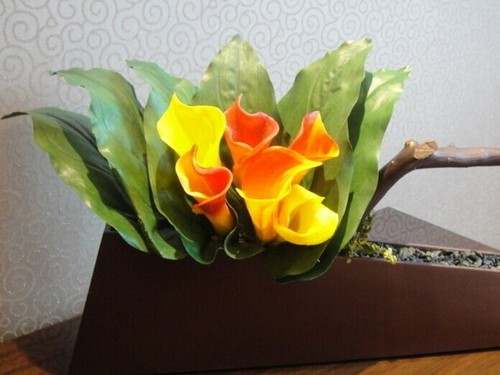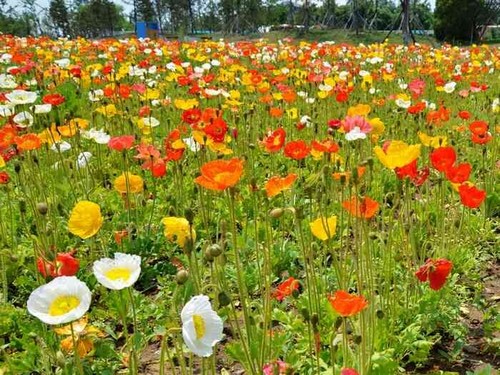Propagation methods of calla lilies
The main way of reproduction is to divide balls. After the plant enters the dormant period, peel off the small balls around the tuber and plant it separately. It can also be sown and propagated, and the seeds can be sown in pots as soon as the seeds are ripe. The suitable temperature for germination is about 20 ℃.
Cultivated calla lilies usually plant balls after autumn. Bed planting row spacing 25cm, plant spacing 10cm. Use fertile and slightly clayey soil, such as 2 parts of garden soil, 1 part of rice chaff ash, with a little bone meal or barnyard manure, or 2 parts of fine broken pond mud, 1 part of rotten leaf soil (or compost), and soil prepared with appropriate amount of calcium superphosphate and mature cow dung. After planting, the 3~4cm covered with soil is thick, and the seedlings can emerge in about 20 days. Calla lilies like to have plenty of water during their growth, so they should often sprinkle water on the leaves and the ground, and pay attention to the cleanliness of the leaves. Liquid fertilizer was applied once every semimonthly. Rinse with clean water immediately after fertilization, in case of accident, move into the greenhouse before frost and keep room temperature above 10 ℃.

In order to avoid the influence of leaves on daylighting during maintenance, the outer leaves can be removed, which is also conducive to pedicel protruding. The flowering period is from February to April, and the watering stops gradually after flowering; after May, the plant begins to wither and yellow, so it should be ventilated and kept dry to prevent tuber from rotting. When the plant is completely dormant, the tubers can be taken out, dried and stored, and then planted in autumn.
The cultivation technique calla is suitable for planting from late August to early September, and the ground planting is used for cut flower production. If the robust rhizome is planted in a fertile field, New Year's Day can blossom and supply the market. There are 2 to 3 big balls and 1 to 2 small balls in each potted plant. Garden soil and organic fertilizer can be used in potted soil. Plant in a semi-shaded place, sprout in the sun, wait for Frosts Descent to move to the greenhouse, keep the room temperature above 10 degrees.
During the growth period, it is necessary to keep the basin soil moist, usually sprinkling water to the leaf surface and the ground to increase air humidity. Liquid fertilizer was applied once every semimonthly. Phosphate fertilizer should be applied before flowering to control stem and leaf growth, promote flower bud differentiation and ensure flower quality. Do not let fertilizer and water flow into the petiole when fertilizing, so as not to cause rot. If there are too many leaves during the growth period, a few external old leaves can be removed to facilitate the extraction of pedicels. February to May is the flowering and luxuriant period. After the hot day in late May, the plants began to wither and yellow, so they should be gradually stopped watering to moderate shade to prevent stagnant water.
Potted plants should be moved to ventilated, semi-shaded places, so that the pot side, do not accumulate Rain Water, in order to keep dry, promote its dormancy. After all the leaves are withered and yellow, the bulbs can be taken out, dried and stored in a cool and ventilated place. Before planting in autumn, the senescent part of the bulb base was cut off and replanted. Big balls blossom, but small balls can raise seedlings. The main disease of diseases and insect pests is soft rot. The prevention and control methods include pulling out diseased plants, disinfecting planting holes with 200 times formalin, avoiding continuous cropping as far as possible, timely drainage, proper ventilation and spraying Bordeaux solution when the disease occurs. Insect pests are mainly red spiders. It can be prevented and treated with 3000-fold solution of phosphorus trisulfide.
Time: 2019-06-11 Click:
- Prev

Control of diseases and insect pests of edible fungi, how to control brown rot of edible fungi?
How to prevent and cure edible fungus brown rot?
- Next

The method of sowing and breeding of Yu Beauty
Yu Mei often uses sowing and reproduction, and the survival rate of transplantation is low, so it is appropriate to use open-field direct seeding. Autumn sowing is generally in early September, but it can also be sown in spring, that is, sowing when the land is thawed in early spring, using strip sowing. The distance between the seedlings of autumn sowing and spring sowing is 2030 cm and 1525 cm respectively, and the suitable temperature for germination is 15 ℃ ~ 20 ℃.
Related
- Fuxing push coffee new agricultural production and marketing class: lack of small-scale processing plants
- Jujube rice field leisure farm deep ploughing Yilan for five years to create a space for organic food and play
- Nongyu Farm-A trial of organic papaya for brave women with advanced technology
- Four points for attention in the prevention and control of diseases and insect pests of edible fungi
- How to add nutrient solution to Edible Fungi
- Is there any good way to control edible fungus mites?
- Open Inoculation Technology of Edible Fungi
- Is there any clever way to use fertilizer for edible fungus in winter?
- What agents are used to kill the pathogens of edible fungi in the mushroom shed?
- Rapid drying of Edible Fungi

